Yesterday morning I joined a group of fellow Native Plant Society members to tour another member’s wildlife garden. Jackie has lived at her house since 1997, gardening from the start to make her yard a nature’s delight for humans and wildlife alike.
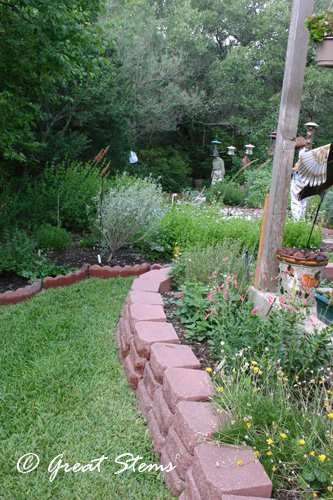 Goodbye Arizona Ash and a Chinese exotic tree, the name of which escapes me. Goodbye excessive lawn. Hello native plants. Hello blooms, birds, butterflies, and bees.
Goodbye Arizona Ash and a Chinese exotic tree, the name of which escapes me. Goodbye excessive lawn. Hello native plants. Hello blooms, birds, butterflies, and bees.
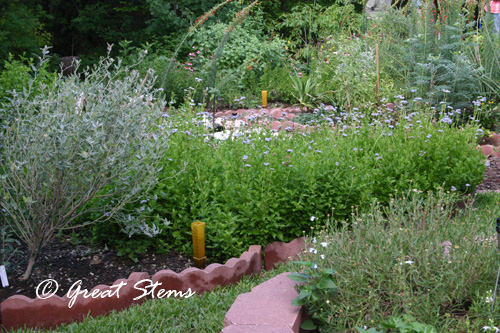
The sideyard grass path lead us to quite a surprise — a backyard rich in color, variety, and wildlife visitors. Pipevine swallowtails were constantly fluttering around, hummingbirds obsessed over the Standing Cypress blooms, and native bees ignored all the human visitors and went about gathering pollen like nobody’s bzzzzzness.
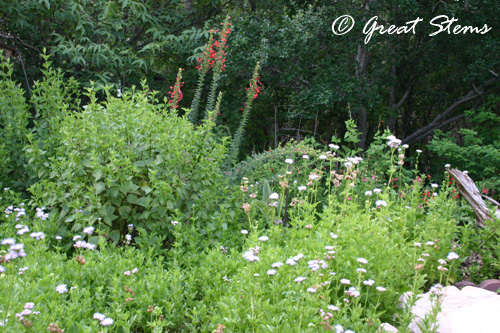
To achieve such a gathering of wildlife, Jackie plants native plants that serve as host plants for caterpillars and nectar-, pollen-, and seed-providing plants for other animals.
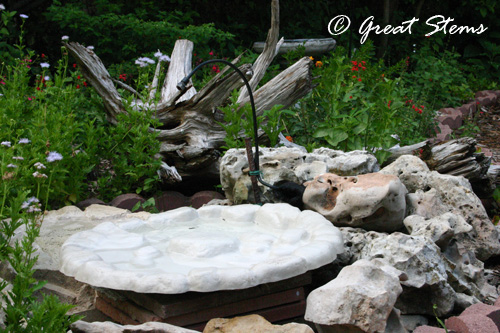
Of course, she also makes sure to include the very necessary habitat element of water. The above birdbath provides a drip to create water movement that birds appreciate.
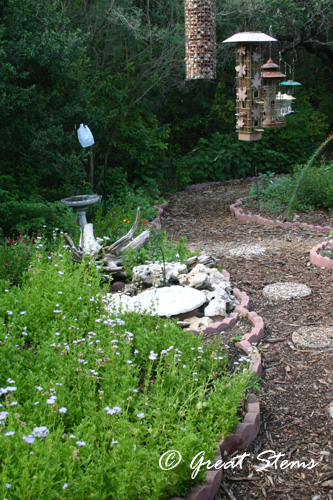 But just beyond, Jackie also makes use of a simpler system, a jug of water with a pinhole at the bottom, allowing a very slow drip to add movement to the birdbath water below.
But just beyond, Jackie also makes use of a simpler system, a jug of water with a pinhole at the bottom, allowing a very slow drip to add movement to the birdbath water below.
An avid birder, Jackie not only provides native plants that birds enjoy, but she also supplements with multiple birdfeeders strung along long cables.
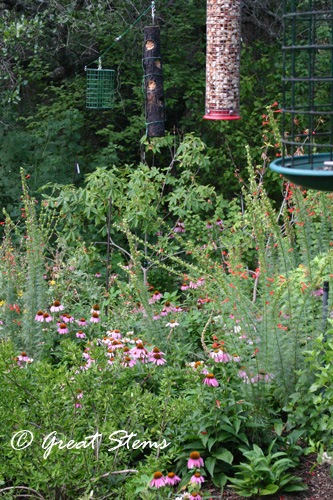 Jackie commented that others might find the string of birdfeeders odd, but I found it quite clever. During our visit, it was clear that the birds utilized the line as a perch as much as they used the feeders themselves. Jackie hung the feeder line in such a way that sunflower seeds would fall onto the path rather than into her garden, so that she could easily control any seedlings that might crop up, so to speak.
Jackie commented that others might find the string of birdfeeders odd, but I found it quite clever. During our visit, it was clear that the birds utilized the line as a perch as much as they used the feeders themselves. Jackie hung the feeder line in such a way that sunflower seeds would fall onto the path rather than into her garden, so that she could easily control any seedlings that might crop up, so to speak.
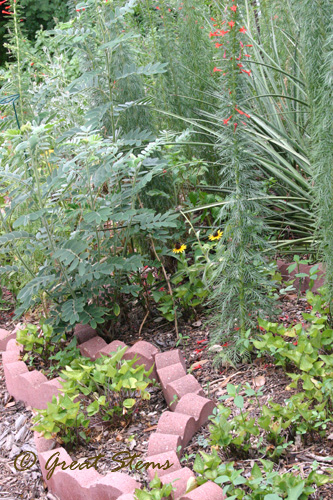
The diversity of natives is the key to a successful wildlife garden. Jackie doesn’t aim for perfect patches of neatly-arranged plant species, but lets the plants gather in natural masses in the dense cover-providing style that is found in nature and that native animals prefer. This controlled but somewhat untamed appearance is sometimes a look that other gardeners have firm opinions about, but the success of such of garden in attracting wildlife speaks for itself.
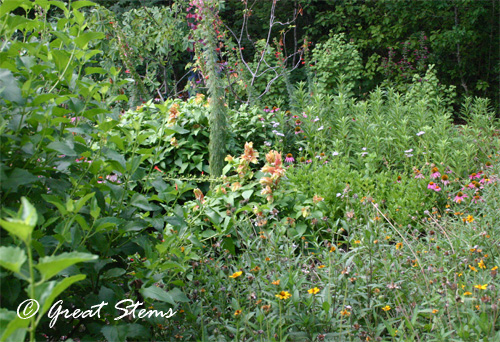
Jackie’s garden exhibits a little of all lighting types — sun, shade, and in between — so she’s able to increase the native plant and subsequent wildlife diversity just by knowing the habits of the plants she selected. Though I didn’t get images of the more wooded areas in the back of the yard, the combination of trees and understory provided a peaceful habitat for those creatures more content in the shade.
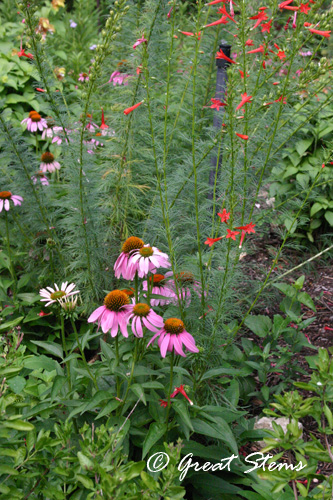 I was jealous of all the Purple Coneflowers — clearly I need to increase the quantity in my own garden by a lot. But I went truly gaga for the Standing Cypress. Rather than being kept together in a single mass, these tall, Dr. Seuss plants were scattered among the rest of the garden.
I was jealous of all the Purple Coneflowers — clearly I need to increase the quantity in my own garden by a lot. But I went truly gaga for the Standing Cypress. Rather than being kept together in a single mass, these tall, Dr. Seuss plants were scattered among the rest of the garden.
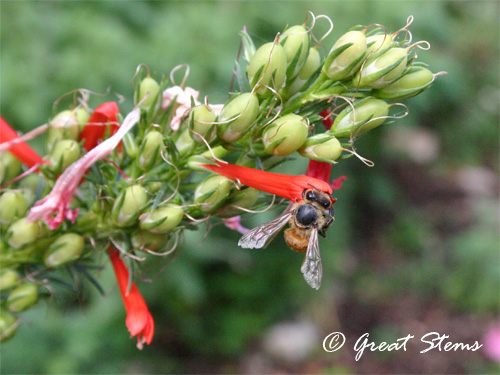 Frankly, I loved the effect, and visiting hummingbirds and bees said the same thing. Two-dimensional images just can’t do it justice.
Frankly, I loved the effect, and visiting hummingbirds and bees said the same thing. Two-dimensional images just can’t do it justice.
Back in the side yard, Jackie’s Trumpet Vine (also called Trumpet Creeper) was covered in seedpods, blooms, and nectar-loving ants.
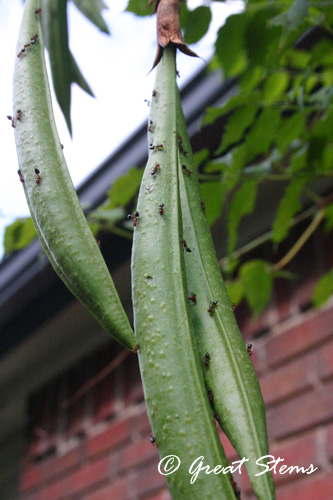
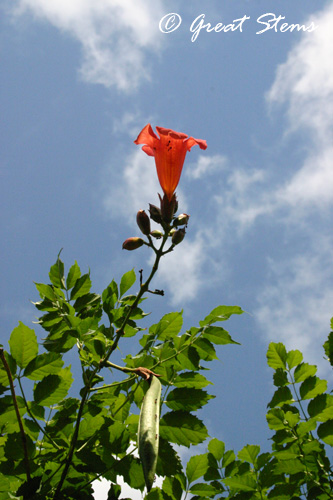 Though Jackie’s Trumpet Vine appeared quite under her control, this aggressive spreader can sometimes become a gardener’s nightmare (it’s called a creeper for a reason), but its plentiful nectar makes it a wildlife favorite. Ants come with the package — I found it fascinating how they laid claim to the entire vine.
Though Jackie’s Trumpet Vine appeared quite under her control, this aggressive spreader can sometimes become a gardener’s nightmare (it’s called a creeper for a reason), but its plentiful nectar makes it a wildlife favorite. Ants come with the package — I found it fascinating how they laid claim to the entire vine.
Across the path from the Trumpet Vine was a Devil’s Shoestring in bloom.
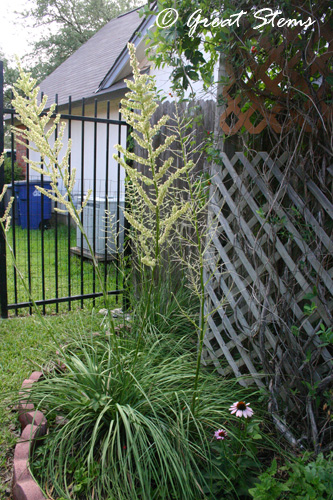
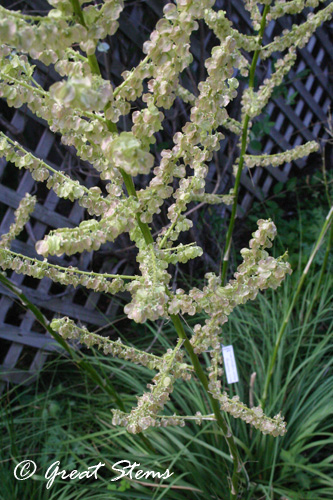 I fell in love with the creamy blooms. Why don’t I have this in my garden yet?
I fell in love with the creamy blooms. Why don’t I have this in my garden yet?
While Jackie has greatly reduced her lawn size, she does maintain some grass for pathway purposes. In the wildlife garden, however, she uses cedar mulch. The colorful garden, alive with happy creatures, certainly was a treat. Jackie, thank you for letting us visit.
After the garden tour, Nolan and I joined others for a walk through Brodie Wild, a habitat restoration and water quality protection project in South Austin, and then it was off to the Pond Tour. At this point, my ailing camera took a turn for the worst. We’ll see if I get to post photos or not.
I never heard of standing cypress before, but you have me intrigued … It is hard to capture the effect of tall plants with small tubular flowers. I have that problem with salvia guaranitica – it just doesn’t show its charm in photos. I too, like coneflowers. They do seed themselves in, if you’re patient …
I appreciate all the photos of another gardener who gardens for wildlife …
Sheila, I do have a lot of area to fill in — I best give the coneflowers and standing cypress a hand. Some seeds here, some plants there… Glad you garden for wildlife!
Great tour! And I love the color combo of the coneflower and standing cypress (for some reason, I have trouble getting coneflowers to stay alive, but cypress pop up everywhere, especially in the newer decomposed granite areas). Lots of clever ideas for the birds that I might have to borrow.
Ah, *that* cypress! Ipomopsis. I was thinking of trees, trying to figure out what you were talking about. 🙂
I wasn’t aware that these could take the heat, as I’ve grown a few years ago. I do remember them getting flattened by storms though. Still, I’ll have to give them another try I think.
I have standing cypress out in the wild area in front of my house – it is one of my favorites! Thanks for posting pictures of this wonderful yard. What a great space!
Oh, I’ll be borrowing those ideas, too, Amy!
I had the same reaction the first time I heard the name, Alan. That’s why I think of it more as the Dr. Seuss plant — what it has to do with cypress I have no idea.
Cynthia, I’m so glad you liked the garden — it was such a pleasant place to visit!
Thank you so much for your blog, I was unable to go due to being out of town but felt like, thanks to you, I got to see a part of it,
anyway. Your pictures were beautiful.
Sally Scott
Sally, I’m glad that you enjoyed the online tour. Jackie has really got a special garden — I was very happy that she let me share pictures of it!
Ok I feel better about my gardens now…I strive to get where Jackie is and am on my way…my grass paths and natural look with more and more natives is for the wildlife and me…I do not need neat beds without weeds…thx for the wonderful tour…I am back to where I needed to be
What a beautiful garden and your documentation is wonderful! Not to steal your connection, but would Jackie open her garden to CTG?
Donna, I feel the same way!
Linda, I’m going to send your message to Jackie, so you two can chat. Jackie’s garden would be a great CTG feature, if she’s willing!
Spectacular. I love touring other people’s homes to get ideas. This yard/garden looks like a delight; full of many treasures!
Love this garden! I too have a wildlife garden in odessa, Texas. This year has been a callange for all of this area. Only a trace of rain since Sept. of 2010, and heat in the 100,s almost every day. Our garden has become an osasis,with all sorts of wildlife and birds. WE have a cougar that comes to our pond to drink, also numerous bob cats and cyotes.WE have birds that are normaly not in this area now.I grow native and adapted plants to feed butterflies,birds,and rabbits,which in turn feeds the rest of the food chain. All the way up to the cougar. We are also a monarch way station, and have thousands of Monarchs arrive with the first Canadian cold front in the fall.Come and visit us if you are ever in this area.Go to chambers secret garden Odessa Texas, to see our web site.
Does anyone know if it is possible to grow “Standing cypress” up in Wisconsin ?
I think Standing Cypress is found there, Ed — I hope so, because you’ll love it!